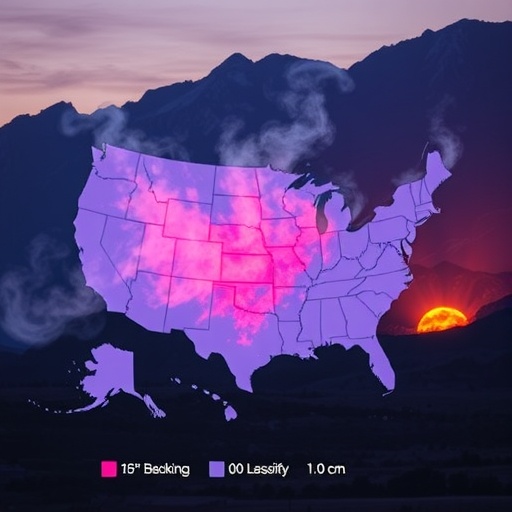
In a groundbreaking study published in the Journal of Exposure Science and Environmental Epidemiology, researchers have unveiled striking differences in the serum concentrations of per- and polyfluoroalkyl substances (PFAS) among various occupational groups in Arizona from 2020 to 2023. This comprehensive investigation provides a critical lens into how environmental exposure to these persistent and potentially harmful chemicals varies among firefighters, other first responders, healthcare workers, and essential workers, implications of which stretch far beyond local boundaries into broader public health concerns.
PFAS are a large class of synthetic chemicals extensively utilized in industrial applications and consumer goods due to their resistance to heat, water, and oil. Their unique chemical properties have led to widespread use in firefighting foams, non-stick cookware, stain repellents, and food packaging. However, these same properties contribute to their persistence in the environment and the human body, earning them the moniker “forever chemicals.” These compounds do not easily degrade, leading to accumulation in biological systems, raising alarms about their long-term health effects, including cancer, immune system disruptions, and hormonal imbalances.
The study conducted by Mitchell, C.L., Hollister, J., Fisher, J.M., and colleagues employed rigorous serum biomonitoring techniques, measuring PFAS concentrations across diverse workforce populations in Arizona. The cohort included firefighters, emergency medical personnel, law enforcement officers, healthcare professionals, and other essential workers engaged in various sectors during the intensification of the COVID-19 pandemic and its aftermath. This period, marked by altered work patterns and heightened safety precautions, provided a unique backdrop for assessing occupational exposure to PFAS.
One of the most compelling findings was the elevated serum PFAS levels observed in firefighters compared to other occupational categories. This trend closely aligns with previous studies linking the use of aqueous film-forming foams (AFFFs) in firefighting to increased PFAS body burdens. AFFFs have been a standard firefighting agent for decades, prized for their effectiveness in controlling fuel fires but notorious for their high PFAS content. Firefighters’ repeated exposure during fire suppression activities, equipment maintenance, and station contamination emerged as key contributing factors to their elevated body burdens.
Conversely, healthcare workers and many other essential workers showed comparatively lower PFAS serum concentrations. These groups, despite increased occupational hazards during the pandemic, generally had less direct interaction with PFAS-laden materials, indicating that occupational environment significantly modulates PFAS exposure risk. However, healthcare workers displayed subtle variations possibly linked to the use of PFAS-containing medical products or personal protective equipment, underlining the complex pathways through which these substances infiltrate human systems.
The researchers underscored the role of environmental contamination and workplace safety protocols in mediating PFAS exposure. Many firefighting stations had detectable environmental PFAS contamination, often resulting from historical use of AFFFs, which can persist in dust and surfaces. This environmental reservoir contributes to chronic low-level exposure, emphasizing the necessity of rigorous decontamination procedures and the evaluation of alternative firefighting agents with reduced PFAS content.
Technological advancements in biomonitoring assays enabled this study to pinpoint specific PFAS congeners in serum samples, elucidating nuanced exposure profiles beyond total PFAS burden. Certain compounds, such as perfluorooctane sulfonate (PFOS) and perfluorooctanoic acid (PFOA), were consistently elevated in firefighters, reflecting their widespread historical use and environmental resilience. Emerging PFAS variants, introduced as replacements for these legacy chemicals, were also detected, indicating occupational uptake of newer formulations whose health impacts remain insufficiently characterized.
The implications of this research resonate profoundly within occupational health frameworks. Understanding the differential exposure patterns informs the development of targeted interventions and regulatory policies aimed at reducing PFAS body burden among vulnerable worker populations. For firefighters, this may entail enhanced personal protective equipment standards, routine biomonitoring, and phased elimination of PFAS-containing firefighting foams. For other workers, continuous surveillance and environmental assessments will be crucial to prevent unforeseen exposure risks as industrial applications evolve.
Notably, the study’s multi-year design allowed the observation of temporal trends, revealing that efforts to mitigate PFAS exposure—such as transitioning away from AFFFs—have begun to reflect in stabilizing or modest declines in firefighter serum PFAS levels post-2021. Nevertheless, entrenched environmental contamination and legacy PFAS release mean that exposure risks persist, necessitating ongoing vigilance. The temporal data also highlighted occasional spikes corresponding to specific fire incidents or changes in occupational practices, illustrating the dynamic nature of exposure scenarios.
Beyond occupational contexts, public health ramifications are considerable. Workers exposed to elevated PFAS levels may inadvertently transport these compounds into their households, contributing to secondary exposure among family members and communities. The study advocates for integrated exposure management encompassing workplace, environmental, and residential domains to curtail this broader transmission pathway.
Moreover, this research invites deeper exploration into the mechanistic pathways of PFAS toxicity in occupationally exposed cohorts. Emerging evidence suggests that chronic PFAS exposure can impair immune function, affect endocrine health, and interfere with metabolism, all of which are critical health determinants for first responders and healthcare workers who already face multifaceted occupational stressors. The intersection of chemical exposure and occupational hazards potentiates risks that warrant comprehensive health monitoring and supportive interventions.
Given the complexity and heterogeneity of PFAS compounds, the study emphasizes the need for inclusive toxicological frameworks that encompass both legacy and novel PFAS substances. Regulatory agencies and scientific bodies are urged to update exposure guidelines and toxicological reference values accordingly. This study’s detailed serum profiling offers valuable benchmarks for such guideline development and risk assessment models.
In synthesizing these findings, stakeholders must recognize that PFAS exposure is not merely a chemical problem but a multifactorial occupational and environmental health challenge intricately tied to industrial practices, regulatory landscapes, and workforce wellbeing. Investment in safer chemical alternatives, combined with robust occupational health monitoring programs, emerges as an ethical and public health imperative.
Ultimately, the Mitchell et al. study illuminates the often-unseen chemical footprints left by heroic emergency responders and essential workers amidst the complex tapestry of modern occupational hazards. Their work serves both as a clarion call for intensified research into PFAS exposure mitigation and as a foundation for policy advancements that safeguard those who protect society’s health and safety.
As we look forward, integrating environmental epidemiology with occupational health surveillance will be pivotal in unraveling the full scope of PFAS-related risks. Collaborative efforts pooling scientific inquiry, public health policy, and industrial innovation hold promise for forging pathways towards a safer, chemical-resilient workforce, where the sacrifices of first responders are not compounded by unseen toxic legacies.
Subject of Research: Differences in serum concentrations of per- and polyfluoroalkyl substances (PFAS) by occupation among firefighters, first responders, healthcare workers, and essential workers in Arizona.
Article Title: Differences in serum concentrations of per-and polyfluoroalkyl substances by occupation among firefighters, other first responders, healthcare workers, and other essential workers in Arizona, 2020–2023.
Article References: Mitchell, C.L., Hollister, J., Fisher, J.M. et al. Differences in serum concentrations of per- and polyfluoroalkyl substances by occupation among firefighters, other first responders, healthcare workers, and other essential workers in Arizona, 2020–2023. J Expo Sci Environ Epidemiol 35, 437–444 (2025). https://doi.org/10.1038/s41370-025-00753-7
Image Credits: AI Generated
DOI: May 2025
Tags: environmental health risks of PFASessential workers and environmental toxinsfirefighters and chemical exposurehealthcare workers PFAS studyimpact of forever chemicals on healthindustrial applications of PFASlong-term effects of PFAS exposureoccupational differences in PFAS levelsPFAS exposure in Arizona workerspublic health implications of PFASserum biomonitoring for PFASsynthetic chemicals in consumer goods



